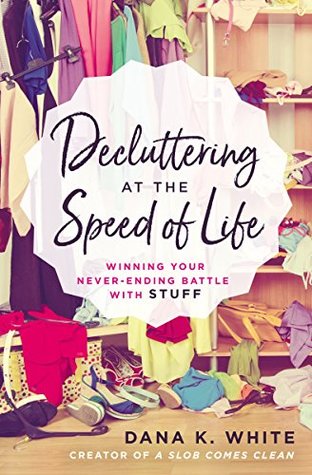 Decluttering at the Speed of Life: Winning Your Never-Ending Battle with Stuff
Decluttering at the Speed of Life: Winning Your Never-Ending Battle with Stuff by
Dana K. White Series: Standalone Published by Thomas Nelson on February 27th 2018
Genres: Non-Fiction,
Self Help Pages: 240
Format: Kindle Edition Source: Bought Buy on Amazon Rating:

You don't have to live overwhelmed by stuff--you can get rid of clutter for good!
While the world seems to be in love with the idea of tiny houses and minimalism, many of us simply can't purge it all and start from nothing. Yet a home with too much stuff is a home that is difficult to maintain, so where do we begin? Add in paralyzing emotional attachments and constant life challenges, and it can feel almost impossible to make real decluttering progress.
In Decluttering at the Speed of Life, decluttering expert and author Dana White identifies the mind-sets and emotional challenges that make it difficult to declutter. Then, in her signature humorous approach, she provides workable solutions to break through these struggles and get clutter out--for good!
But more than simply offering strategies, Dana dives deep into how to implement them, no matter the reader's clutter level or emotional resistance to decluttering. She helps identify procrasticlutter--the stuff that will get done eventually so it doesn't seem urgent--as well as how to make progress when there's no time to declutter.
Sections of the book include
Why You Need This Book (You Know Why)Your Unique HomeDecluttering in the Midst of Real LifeChange Your Mind, Change Your HomeBreaking Through Your Decluttering DelusionsWorking It Out Room by RoomHelping Others DeclutterReal Life Goes On (and On)As long as we're living and breathing, new clutter will appear. The good news is that decluttering can get easier, become more natural, and require significantly fewer hours, less emotional bandwidth, and little to no sweat to keep going.
For the last few years, I’ve been on a mission that I call ‘Simplify’. This generic term covers all aspects of my life, but one of the primary ways has been a decluttering of my living space. I came across this title in my Prime Free reading options this month and I thought I’d see if there was more I could be doing or do it more efficiently in my ongoing pursuit of simplification through decluttering.
I really enjoyed the author’s approach to the subject matter. She approaches this as a mental state of being- a decision that change must take place- and warns of the hardships ahead of parting company with ‘treasures’, but then she leaves the esoteric behind to provide a solid winning formula.
How do I know it’s solid? Well, (pats self on the back) I was already doing most of that without the snazzy labels and steps and it was working. Okay, so I was doing a lot of it, but yes! Yippee! Woohoo! There were indeed some additional, practical steps and tips that I had not considered incorporating or that made some of the agony go away.
Without giving away the spoilery stuff (the actual formula- Decluttering at the Speed of Life), I’ll say that she approaches her house in a layer approach: Daily Stuff, Clutter, and Cleaning. This book addresses that second layer of Clutter. Her formula involves a four-step process and is designed for any space and any amount of time frame so it’s flexible for each person’s unique situation.
She suggests starting with the ‘visible’ and ‘living areas’ of the home first. This means where guests will see and where people do most of their living and are hampered by clutter. Her approach is simple- deal with the least agonizing (like trash or daily drop pile stuff) and working up to the big decision stuff. It’s easiest in the living space rooms that guests see. Then progress to bedrooms, closets, and storage. Hobby or Craft or game rooms that are the most likely to be turned into dumping areas.
Incidentally, I thought a tip that was helpful about decluttering a space is to first determine its function like in those guest/office/hobby rooms that end up catch-alls because the space hasn’t been defined (and this makes it hard to oust the clutter because it has no set primary purpose).
She also carefully says not to deal with ‘dream’ clutter until the last. I thought this was interesting because I figured it would be best to clear a space and move to the next space. But, then I got it. Dream clutter is the toughest to let go of. It’s best to start with the easiest to toss or donate and then get used to the idea and get used to the wonderful feel of functional space before heading into emotional attachment territory.
That leads me to say that she deals with our struggles with guilt when it comes to holding onto stuff. This can be pantry items because we feel guilty tossing food or clothes when someone may be going without. She kept bringing it back to ‘will you eat it or wear it NOW?’ No? Then get rid of it. Leaving it on your shelf or in your closet is not doing that nameless needing person any good. Use the guilt to shop to intentionally meet actual needs and bring home less next time.
She also covers the guilt of keeping something put away that was gifted by a good friend or relation when you don’t really like it and/or don’t ever use it. Aunt Susie made those pot holders to be used. Grandma Anna is gone and won’t know that you passed on her turkey platter because you prefer the one you bought. And, I saw myself doing ‘x, y, z’ rather than what your true reality is. Yep! This area was my big epiphany one.
She also addressed the Useful vs Actually Using issue which is another weak spot for me. If there isn’t space and it isn’t in immediate use then it must be donated. Freeing the space to use the things you actually use is more important than keeping tons of extra on the outside chance it will someday find use. This also led to the understanding of cutting clutter off before it even comes inside the door by not buying bulk or because it’s on sale for future potential use, but only if it will, in fact, be used.
Then, after going over her method and steps and how to address different types of household spaces, she went over how to deal with other’s clutter. This was: friends, kids, older family, spouses, moving, and clearing out the home of someone gone. I found the reminders of how to navigate the complications of helping others to be where I hit pay dirt because I do share my living space with others and I have been asked to come help others or help clear out for others.
Through and through, this was practical and helpful. She has another book about getting organized around the house that sounded like it was a good pairing to go with this one. She also has a blog that might also be helpful. My takeaway is a sense of renewed motivation and plans for working at my goal smarter and not harder.
About Sophia Rose

Sophia is a quiet though curious gal who dabbles in cooking, book reviewing, and gardening. Encouraged and supported by an incredible man and loving family. A Northern Californian transplant to the Great Lakes Region of the US. Lover of Jane Austen, Baseball, Cats, Scooby Doo, and Chocolate.
Facebook | Goodreads
 Fatal Finds in Nuala by Harriet Steel
Fatal Finds in Nuala by Harriet Steel 



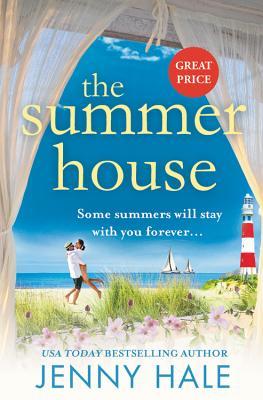 The Summer House by
The Summer House by 
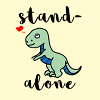

 Only Ever Her by
Only Ever Her by 
 The Mint Julep Murders by
The Mint Julep Murders by 
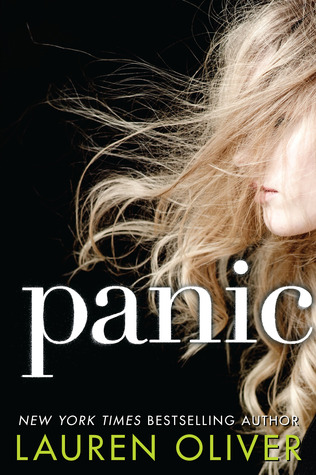 Panic by
Panic by 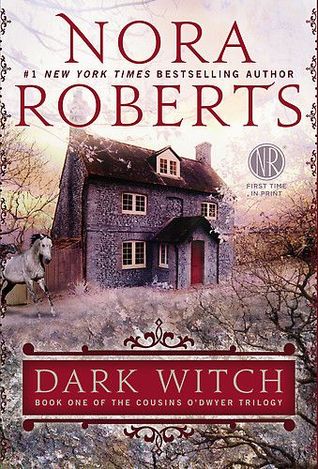 Dark Witch by
Dark Witch by 
 Holy Sister by
Holy Sister by 




 River Queen Rose by
River Queen Rose by 
 When Breath Becomes Air by
When Breath Becomes Air by 
 The Looking Glass by
The Looking Glass by 


 Decluttering at the Speed of Life: Winning Your Never-Ending Battle with Stuff by
Decluttering at the Speed of Life: Winning Your Never-Ending Battle with Stuff by 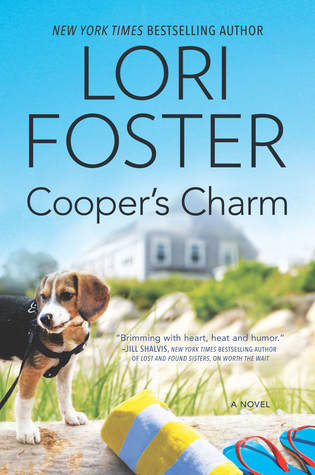 Cooper's Charm by
Cooper's Charm by 


 From This Moment by
From This Moment by 
